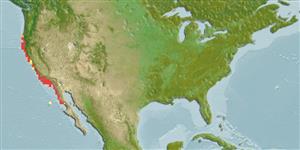Environment: milieu / climate zone / depth range / distribution range
Ecology
Marine; demersal; depth range 31 - 247 m (Ref. 2850). Subtropical; 46°N - 28°N, 125°W - 114°W
Eastern Pacific: Oregon (Ref. 45591), Fort Bragg in northern California, USA to central Baja California and Guadalupe Island (off northern central Baja California) in Mexico.
Length at first maturity / Size / Weight / Age
Maturity: Lm 34.0, range 32 - ? cm
Max length : 54.0 cm TL male/unsexed; (Ref. 5483); max. published weight: 2.0 kg (Ref. 40637); max. reported age: 85 years (Ref. 56049)
Adults demersal and semi-pelagic (Ref. 36715), in offshore areas (Ref. 2850). Juveniles are pelagic (Ref. 36715). Viviparous, with planktonic larvae (Ref. 36715).
Eschmeyer, W.N., E.S. Herald and H. Hammann, 1983. A field guide to Pacific coast fishes of North America. Boston (MA, USA): Houghton Mifflin Company. xii+336 p. (Ref. 2850)
IUCN Red List Status (Ref. 130435: Version 2024-1)
Threat to humans
Harmless
Human uses
Fisheries: commercial; gamefish: yes
Tools
Special reports
Download XML
Internet sources
Estimates based on models
Preferred temperature (Ref.
123201): 8.4 - 10.6, mean 9.5 °C (based on 8 cells).
Phylogenetic diversity index (Ref.
82804): PD
50 = 0.5000 [Uniqueness, from 0.5 = low to 2.0 = high].
Bayesian length-weight: a=0.01000 (0.00495 - 0.02022), b=3.09 (2.92 - 3.26), in cm total length, based on LWR estimates for this Genus-body shape (Ref.
93245).
Trophic level (Ref.
69278): 3.8 ±0.5 se; based on size and trophs of closest relatives
Resilience (Ref.
120179): Very Low, minimum population doubling time more than 14 years (tm=15; tmax=85).
Fishing Vulnerability (Ref.
59153): Moderate vulnerability (42 of 100).
